Brand Management Report: Strategies, Challenges, and Portfolio
VerifiedAdded on 2020/09/17
|15
|4107
|45
Report
AI Summary
This report delves into the intricacies of brand management, exploring key concepts such as brand equity, the significance of branding as a marketing tool, and the differences between a product and a brand. It examines successful brand strategies, their major components, and the development and management of a brand, including challenges like health trends and emerging market performance. The report analyzes various strategies for brand portfolio management, including driving revenue and profit growth, investment in brands, and enhancing efficiency. It also covers collaborative brand management and methods for managing brand value. The analysis includes examples from the Coca-Cola brand, illustrating practical applications of the discussed concepts. The report provides a comprehensive overview of brand management principles and their practical implications in the business world.
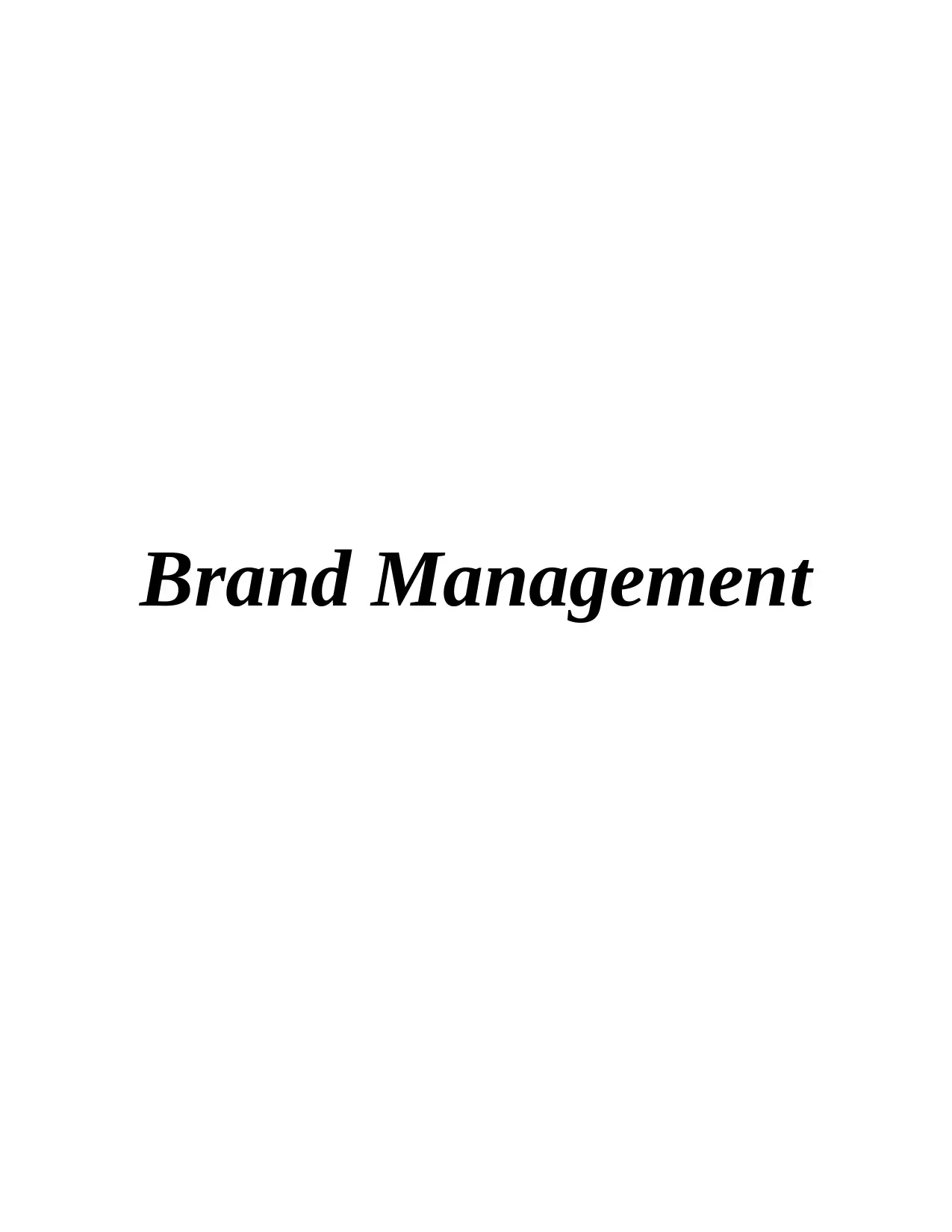
Brand Management
Paraphrase This Document
Need a fresh take? Get an instant paraphrase of this document with our AI Paraphraser
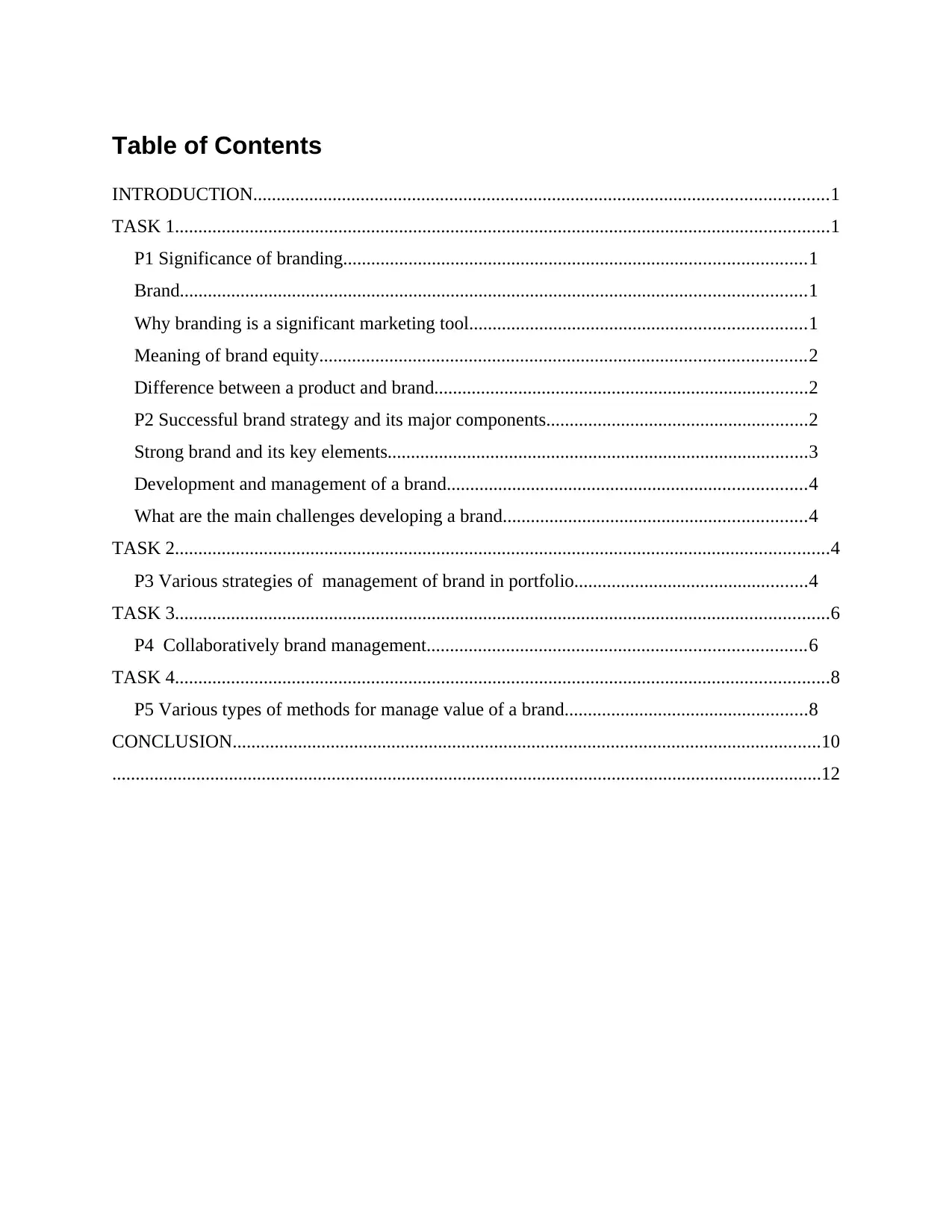
Table of Contents
INTRODUCTION...........................................................................................................................1
TASK 1............................................................................................................................................1
P1 Significance of branding...................................................................................................1
Brand......................................................................................................................................1
Why branding is a significant marketing tool........................................................................1
Meaning of brand equity........................................................................................................2
Difference between a product and brand................................................................................2
P2 Successful brand strategy and its major components........................................................2
Strong brand and its key elements..........................................................................................3
Development and management of a brand.............................................................................4
What are the main challenges developing a brand.................................................................4
TASK 2............................................................................................................................................4
P3 Various strategies of management of brand in portfolio..................................................4
TASK 3............................................................................................................................................6
P4 Collaboratively brand management.................................................................................6
TASK 4............................................................................................................................................8
P5 Various types of methods for manage value of a brand....................................................8
CONCLUSION..............................................................................................................................10
........................................................................................................................................................12
INTRODUCTION...........................................................................................................................1
TASK 1............................................................................................................................................1
P1 Significance of branding...................................................................................................1
Brand......................................................................................................................................1
Why branding is a significant marketing tool........................................................................1
Meaning of brand equity........................................................................................................2
Difference between a product and brand................................................................................2
P2 Successful brand strategy and its major components........................................................2
Strong brand and its key elements..........................................................................................3
Development and management of a brand.............................................................................4
What are the main challenges developing a brand.................................................................4
TASK 2............................................................................................................................................4
P3 Various strategies of management of brand in portfolio..................................................4
TASK 3............................................................................................................................................6
P4 Collaboratively brand management.................................................................................6
TASK 4............................................................................................................................................8
P5 Various types of methods for manage value of a brand....................................................8
CONCLUSION..............................................................................................................................10
........................................................................................................................................................12
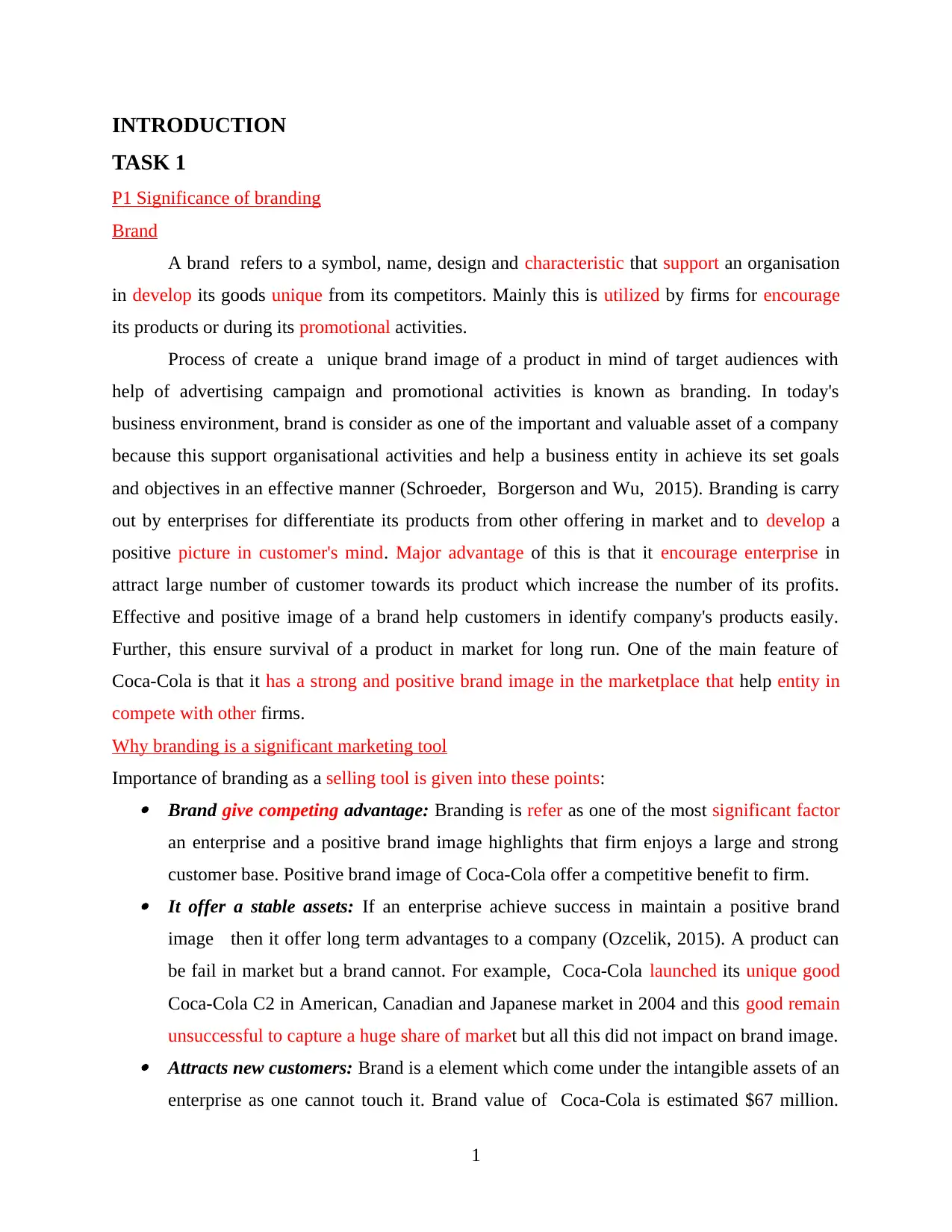
INTRODUCTION
TASK 1
P1 Significance of branding
Brand
A brand refers to a symbol, name, design and characteristic that support an organisation
in develop its goods unique from its competitors. Mainly this is utilized by firms for encourage
its products or during its promotional activities.
Process of create a unique brand image of a product in mind of target audiences with
help of advertising campaign and promotional activities is known as branding. In today's
business environment, brand is consider as one of the important and valuable asset of a company
because this support organisational activities and help a business entity in achieve its set goals
and objectives in an effective manner (Schroeder, Borgerson and Wu, 2015). Branding is carry
out by enterprises for differentiate its products from other offering in market and to develop a
positive picture in customer's mind. Major advantage of this is that it encourage enterprise in
attract large number of customer towards its product which increase the number of its profits.
Effective and positive image of a brand help customers in identify company's products easily.
Further, this ensure survival of a product in market for long run. One of the main feature of
Coca-Cola is that it has a strong and positive brand image in the marketplace that help entity in
compete with other firms.
Why branding is a significant marketing tool
Importance of branding as a selling tool is given into these points: Brand give competing advantage: Branding is refer as one of the most significant factor
an enterprise and a positive brand image highlights that firm enjoys a large and strong
customer base. Positive brand image of Coca-Cola offer a competitive benefit to firm. It offer a stable assets: If an enterprise achieve success in maintain a positive brand
image then it offer long term advantages to a company (Ozcelik, 2015). A product can
be fail in market but a brand cannot. For example, Coca-Cola launched its unique good
Coca-Cola C2 in American, Canadian and Japanese market in 2004 and this good remain
unsuccessful to capture a huge share of market but all this did not impact on brand image. Attracts new customers: Brand is a element which come under the intangible assets of an
enterprise as one cannot touch it. Brand value of Coca-Cola is estimated $67 million.
1
TASK 1
P1 Significance of branding
Brand
A brand refers to a symbol, name, design and characteristic that support an organisation
in develop its goods unique from its competitors. Mainly this is utilized by firms for encourage
its products or during its promotional activities.
Process of create a unique brand image of a product in mind of target audiences with
help of advertising campaign and promotional activities is known as branding. In today's
business environment, brand is consider as one of the important and valuable asset of a company
because this support organisational activities and help a business entity in achieve its set goals
and objectives in an effective manner (Schroeder, Borgerson and Wu, 2015). Branding is carry
out by enterprises for differentiate its products from other offering in market and to develop a
positive picture in customer's mind. Major advantage of this is that it encourage enterprise in
attract large number of customer towards its product which increase the number of its profits.
Effective and positive image of a brand help customers in identify company's products easily.
Further, this ensure survival of a product in market for long run. One of the main feature of
Coca-Cola is that it has a strong and positive brand image in the marketplace that help entity in
compete with other firms.
Why branding is a significant marketing tool
Importance of branding as a selling tool is given into these points: Brand give competing advantage: Branding is refer as one of the most significant factor
an enterprise and a positive brand image highlights that firm enjoys a large and strong
customer base. Positive brand image of Coca-Cola offer a competitive benefit to firm. It offer a stable assets: If an enterprise achieve success in maintain a positive brand
image then it offer long term advantages to a company (Ozcelik, 2015). A product can
be fail in market but a brand cannot. For example, Coca-Cola launched its unique good
Coca-Cola C2 in American, Canadian and Japanese market in 2004 and this good remain
unsuccessful to capture a huge share of market but all this did not impact on brand image. Attracts new customers: Brand is a element which come under the intangible assets of an
enterprise as one cannot touch it. Brand value of Coca-Cola is estimated $67 million.
1
⊘ This is a preview!⊘
Do you want full access?
Subscribe today to unlock all pages.

Trusted by 1+ million students worldwide
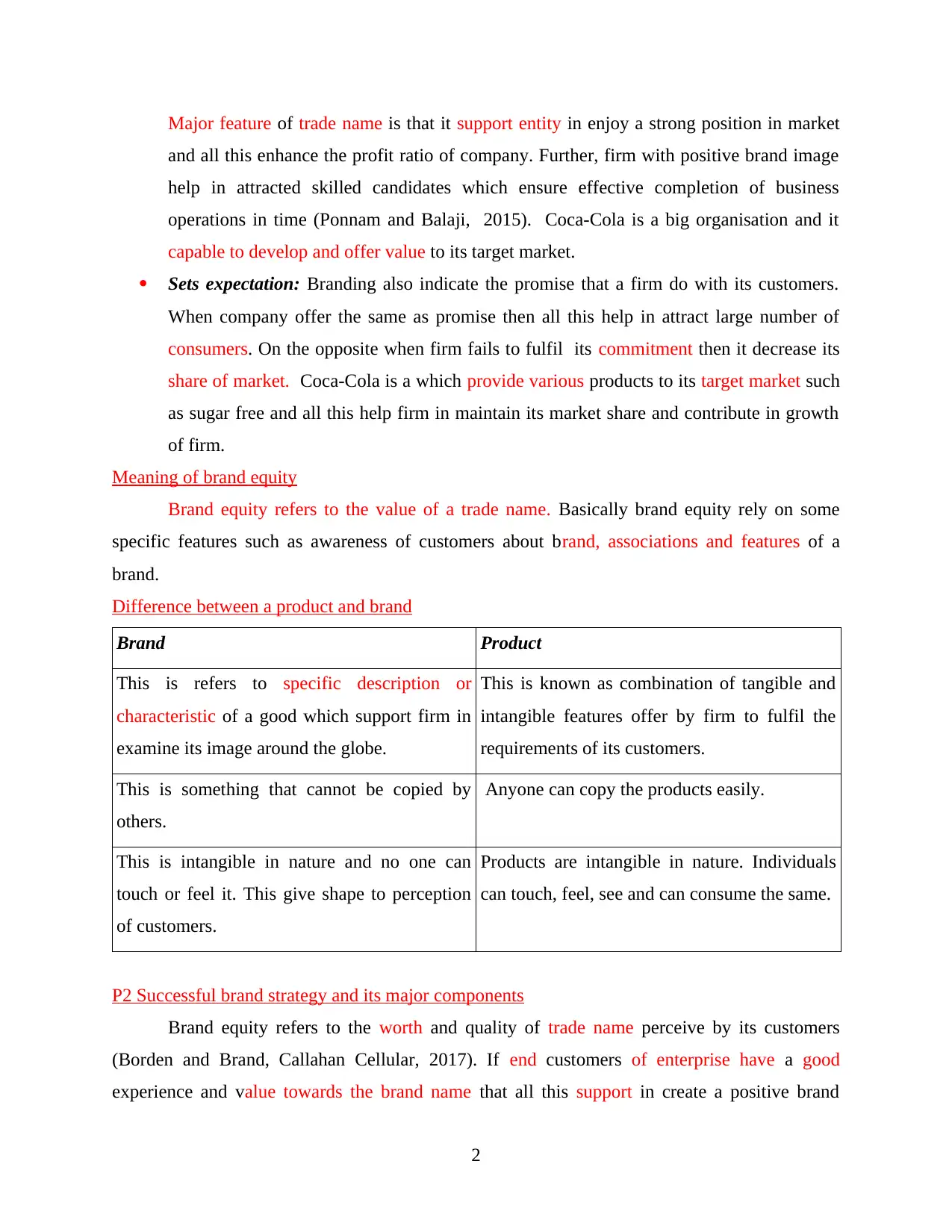
Major feature of trade name is that it support entity in enjoy a strong position in market
and all this enhance the profit ratio of company. Further, firm with positive brand image
help in attracted skilled candidates which ensure effective completion of business
operations in time (Ponnam and Balaji, 2015). Coca-Cola is a big organisation and it
capable to develop and offer value to its target market.
Sets expectation: Branding also indicate the promise that a firm do with its customers.
When company offer the same as promise then all this help in attract large number of
consumers. On the opposite when firm fails to fulfil its commitment then it decrease its
share of market. Coca-Cola is a which provide various products to its target market such
as sugar free and all this help firm in maintain its market share and contribute in growth
of firm.
Meaning of brand equity
Brand equity refers to the value of a trade name. Basically brand equity rely on some
specific features such as awareness of customers about brand, associations and features of a
brand.
Difference between a product and brand
Brand Product
This is refers to specific description or
characteristic of a good which support firm in
examine its image around the globe.
This is known as combination of tangible and
intangible features offer by firm to fulfil the
requirements of its customers.
This is something that cannot be copied by
others.
Anyone can copy the products easily.
This is intangible in nature and no one can
touch or feel it. This give shape to perception
of customers.
Products are intangible in nature. Individuals
can touch, feel, see and can consume the same.
P2 Successful brand strategy and its major components
Brand equity refers to the worth and quality of trade name perceive by its customers
(Borden and Brand, Callahan Cellular, 2017). If end customers of enterprise have a good
experience and value towards the brand name that all this support in create a positive brand
2
and all this enhance the profit ratio of company. Further, firm with positive brand image
help in attracted skilled candidates which ensure effective completion of business
operations in time (Ponnam and Balaji, 2015). Coca-Cola is a big organisation and it
capable to develop and offer value to its target market.
Sets expectation: Branding also indicate the promise that a firm do with its customers.
When company offer the same as promise then all this help in attract large number of
consumers. On the opposite when firm fails to fulfil its commitment then it decrease its
share of market. Coca-Cola is a which provide various products to its target market such
as sugar free and all this help firm in maintain its market share and contribute in growth
of firm.
Meaning of brand equity
Brand equity refers to the value of a trade name. Basically brand equity rely on some
specific features such as awareness of customers about brand, associations and features of a
brand.
Difference between a product and brand
Brand Product
This is refers to specific description or
characteristic of a good which support firm in
examine its image around the globe.
This is known as combination of tangible and
intangible features offer by firm to fulfil the
requirements of its customers.
This is something that cannot be copied by
others.
Anyone can copy the products easily.
This is intangible in nature and no one can
touch or feel it. This give shape to perception
of customers.
Products are intangible in nature. Individuals
can touch, feel, see and can consume the same.
P2 Successful brand strategy and its major components
Brand equity refers to the worth and quality of trade name perceive by its customers
(Borden and Brand, Callahan Cellular, 2017). If end customers of enterprise have a good
experience and value towards the brand name that all this support in create a positive brand
2
Paraphrase This Document
Need a fresh take? Get an instant paraphrase of this document with our AI Paraphraser
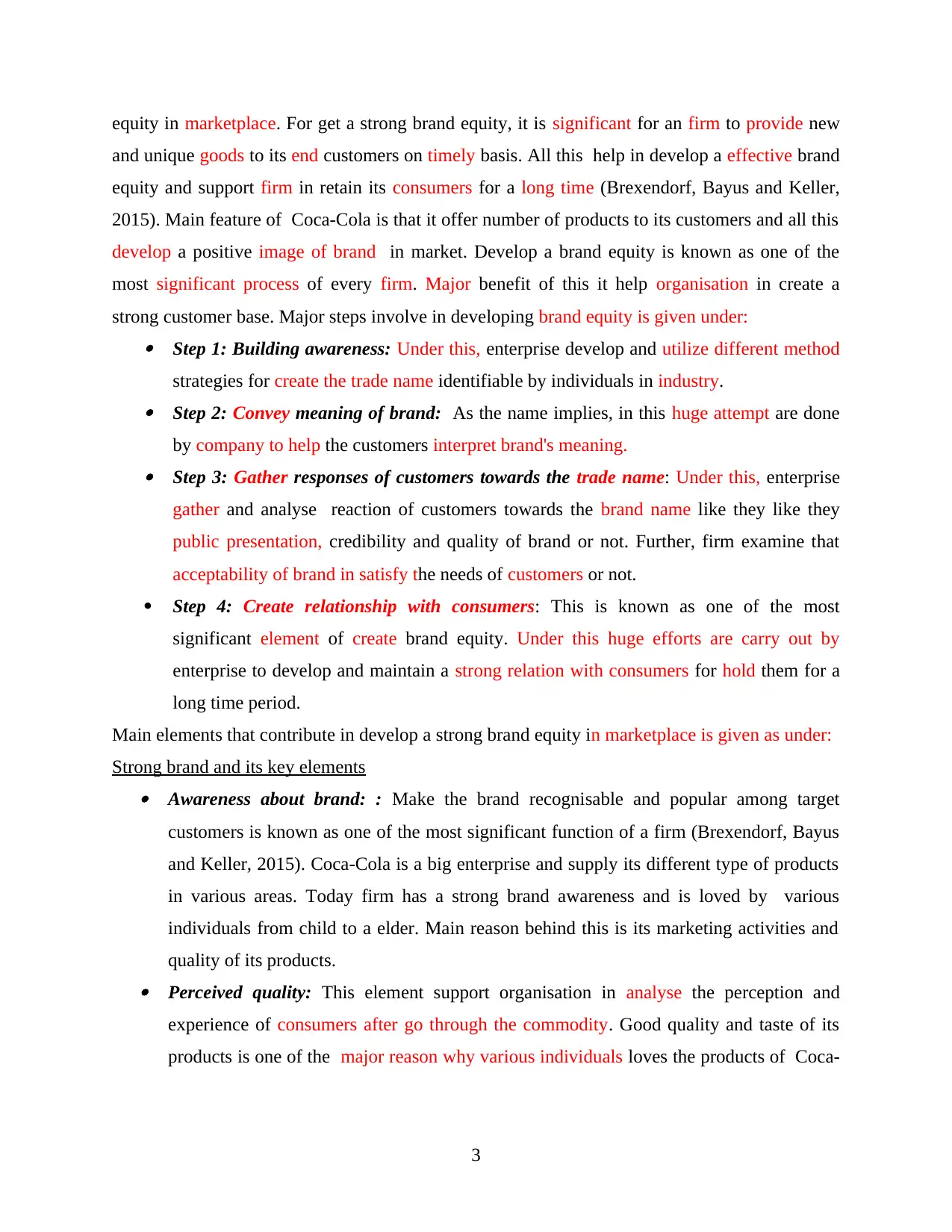
equity in marketplace. For get a strong brand equity, it is significant for an firm to provide new
and unique goods to its end customers on timely basis. All this help in develop a effective brand
equity and support firm in retain its consumers for a long time (Brexendorf, Bayus and Keller,
2015). Main feature of Coca-Cola is that it offer number of products to its customers and all this
develop a positive image of brand in market. Develop a brand equity is known as one of the
most significant process of every firm. Major benefit of this it help organisation in create a
strong customer base. Major steps involve in developing brand equity is given under: Step 1: Building awareness: Under this, enterprise develop and utilize different method
strategies for create the trade name identifiable by individuals in industry. Step 2: Convey meaning of brand: As the name implies, in this huge attempt are done
by company to help the customers interpret brand's meaning. Step 3: Gather responses of customers towards the trade name: Under this, enterprise
gather and analyse reaction of customers towards the brand name like they like they
public presentation, credibility and quality of brand or not. Further, firm examine that
acceptability of brand in satisfy the needs of customers or not.
Step 4: Create relationship with consumers: This is known as one of the most
significant element of create brand equity. Under this huge efforts are carry out by
enterprise to develop and maintain a strong relation with consumers for hold them for a
long time period.
Main elements that contribute in develop a strong brand equity in marketplace is given as under:
Strong brand and its key elements Awareness about brand: : Make the brand recognisable and popular among target
customers is known as one of the most significant function of a firm (Brexendorf, Bayus
and Keller, 2015). Coca-Cola is a big enterprise and supply its different type of products
in various areas. Today firm has a strong brand awareness and is loved by various
individuals from child to a elder. Main reason behind this is its marketing activities and
quality of its products. Perceived quality: This element support organisation in analyse the perception and
experience of consumers after go through the commodity. Good quality and taste of its
products is one of the major reason why various individuals loves the products of Coca-
3
and unique goods to its end customers on timely basis. All this help in develop a effective brand
equity and support firm in retain its consumers for a long time (Brexendorf, Bayus and Keller,
2015). Main feature of Coca-Cola is that it offer number of products to its customers and all this
develop a positive image of brand in market. Develop a brand equity is known as one of the
most significant process of every firm. Major benefit of this it help organisation in create a
strong customer base. Major steps involve in developing brand equity is given under: Step 1: Building awareness: Under this, enterprise develop and utilize different method
strategies for create the trade name identifiable by individuals in industry. Step 2: Convey meaning of brand: As the name implies, in this huge attempt are done
by company to help the customers interpret brand's meaning. Step 3: Gather responses of customers towards the trade name: Under this, enterprise
gather and analyse reaction of customers towards the brand name like they like they
public presentation, credibility and quality of brand or not. Further, firm examine that
acceptability of brand in satisfy the needs of customers or not.
Step 4: Create relationship with consumers: This is known as one of the most
significant element of create brand equity. Under this huge efforts are carry out by
enterprise to develop and maintain a strong relation with consumers for hold them for a
long time period.
Main elements that contribute in develop a strong brand equity in marketplace is given as under:
Strong brand and its key elements Awareness about brand: : Make the brand recognisable and popular among target
customers is known as one of the most significant function of a firm (Brexendorf, Bayus
and Keller, 2015). Coca-Cola is a big enterprise and supply its different type of products
in various areas. Today firm has a strong brand awareness and is loved by various
individuals from child to a elder. Main reason behind this is its marketing activities and
quality of its products. Perceived quality: This element support organisation in analyse the perception and
experience of consumers after go through the commodity. Good quality and taste of its
products is one of the major reason why various individuals loves the products of Coca-
3
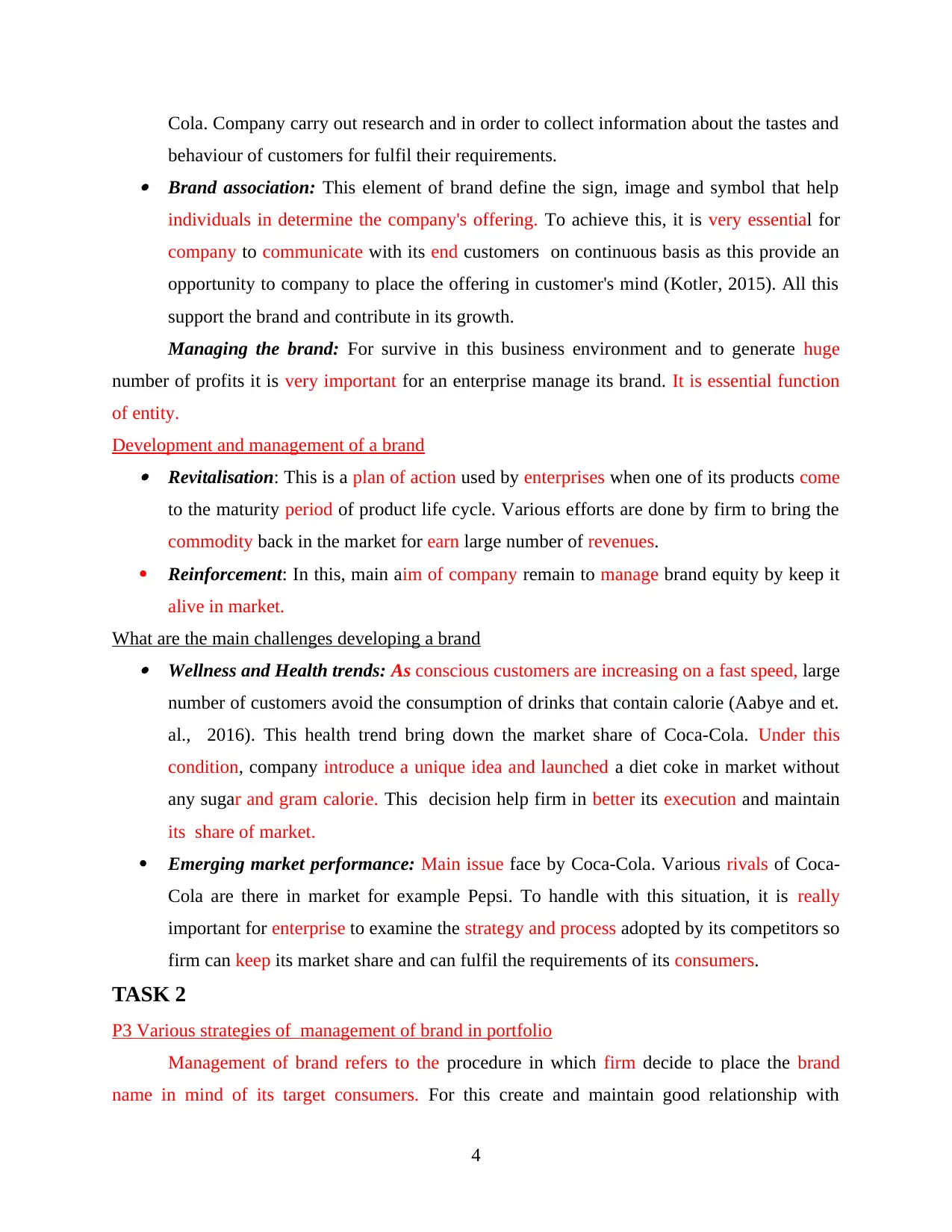
Cola. Company carry out research and in order to collect information about the tastes and
behaviour of customers for fulfil their requirements. Brand association: This element of brand define the sign, image and symbol that help
individuals in determine the company's offering. To achieve this, it is very essential for
company to communicate with its end customers on continuous basis as this provide an
opportunity to company to place the offering in customer's mind (Kotler, 2015). All this
support the brand and contribute in its growth.
Managing the brand: For survive in this business environment and to generate huge
number of profits it is very important for an enterprise manage its brand. It is essential function
of entity.
Development and management of a brand Revitalisation: This is a plan of action used by enterprises when one of its products come
to the maturity period of product life cycle. Various efforts are done by firm to bring the
commodity back in the market for earn large number of revenues.
Reinforcement: In this, main aim of company remain to manage brand equity by keep it
alive in market.
What are the main challenges developing a brand Wellness and Health trends: As conscious customers are increasing on a fast speed, large
number of customers avoid the consumption of drinks that contain calorie (Aabye and et.
al., 2016). This health trend bring down the market share of Coca-Cola. Under this
condition, company introduce a unique idea and launched a diet coke in market without
any sugar and gram calorie. This decision help firm in better its execution and maintain
its share of market.
Emerging market performance: Main issue face by Coca-Cola. Various rivals of Coca-
Cola are there in market for example Pepsi. To handle with this situation, it is really
important for enterprise to examine the strategy and process adopted by its competitors so
firm can keep its market share and can fulfil the requirements of its consumers.
TASK 2
P3 Various strategies of management of brand in portfolio
Management of brand refers to the procedure in which firm decide to place the brand
name in mind of its target consumers. For this create and maintain good relationship with
4
behaviour of customers for fulfil their requirements. Brand association: This element of brand define the sign, image and symbol that help
individuals in determine the company's offering. To achieve this, it is very essential for
company to communicate with its end customers on continuous basis as this provide an
opportunity to company to place the offering in customer's mind (Kotler, 2015). All this
support the brand and contribute in its growth.
Managing the brand: For survive in this business environment and to generate huge
number of profits it is very important for an enterprise manage its brand. It is essential function
of entity.
Development and management of a brand Revitalisation: This is a plan of action used by enterprises when one of its products come
to the maturity period of product life cycle. Various efforts are done by firm to bring the
commodity back in the market for earn large number of revenues.
Reinforcement: In this, main aim of company remain to manage brand equity by keep it
alive in market.
What are the main challenges developing a brand Wellness and Health trends: As conscious customers are increasing on a fast speed, large
number of customers avoid the consumption of drinks that contain calorie (Aabye and et.
al., 2016). This health trend bring down the market share of Coca-Cola. Under this
condition, company introduce a unique idea and launched a diet coke in market without
any sugar and gram calorie. This decision help firm in better its execution and maintain
its share of market.
Emerging market performance: Main issue face by Coca-Cola. Various rivals of Coca-
Cola are there in market for example Pepsi. To handle with this situation, it is really
important for enterprise to examine the strategy and process adopted by its competitors so
firm can keep its market share and can fulfil the requirements of its consumers.
TASK 2
P3 Various strategies of management of brand in portfolio
Management of brand refers to the procedure in which firm decide to place the brand
name in mind of its target consumers. For this create and maintain good relationship with
4
⊘ This is a preview!⊘
Do you want full access?
Subscribe today to unlock all pages.

Trusted by 1+ million students worldwide
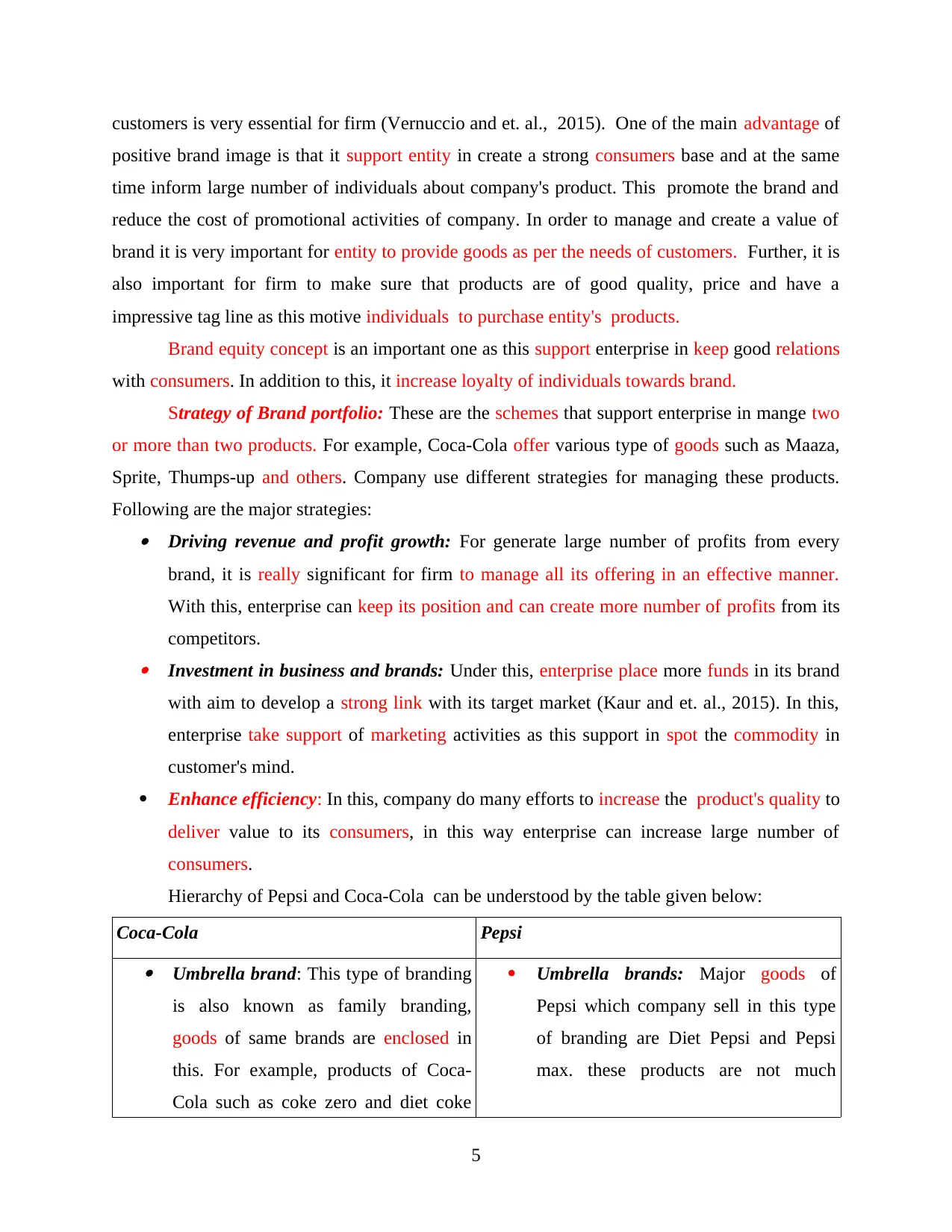
customers is very essential for firm (Vernuccio and et. al., 2015). One of the main advantage of
positive brand image is that it support entity in create a strong consumers base and at the same
time inform large number of individuals about company's product. This promote the brand and
reduce the cost of promotional activities of company. In order to manage and create a value of
brand it is very important for entity to provide goods as per the needs of customers. Further, it is
also important for firm to make sure that products are of good quality, price and have a
impressive tag line as this motive individuals to purchase entity's products.
Brand equity concept is an important one as this support enterprise in keep good relations
with consumers. In addition to this, it increase loyalty of individuals towards brand.
Strategy of Brand portfolio: These are the schemes that support enterprise in mange two
or more than two products. For example, Coca-Cola offer various type of goods such as Maaza,
Sprite, Thumps-up and others. Company use different strategies for managing these products.
Following are the major strategies: Driving revenue and profit growth: For generate large number of profits from every
brand, it is really significant for firm to manage all its offering in an effective manner.
With this, enterprise can keep its position and can create more number of profits from its
competitors. Investment in business and brands: Under this, enterprise place more funds in its brand
with aim to develop a strong link with its target market (Kaur and et. al., 2015). In this,
enterprise take support of marketing activities as this support in spot the commodity in
customer's mind.
Enhance efficiency: In this, company do many efforts to increase the product's quality to
deliver value to its consumers, in this way enterprise can increase large number of
consumers.
Hierarchy of Pepsi and Coca-Cola can be understood by the table given below:
Coca-Cola Pepsi Umbrella brand: This type of branding
is also known as family branding,
goods of same brands are enclosed in
this. For example, products of Coca-
Cola such as coke zero and diet coke
Umbrella brands: Major goods of
Pepsi which company sell in this type
of branding are Diet Pepsi and Pepsi
max. these products are not much
5
positive brand image is that it support entity in create a strong consumers base and at the same
time inform large number of individuals about company's product. This promote the brand and
reduce the cost of promotional activities of company. In order to manage and create a value of
brand it is very important for entity to provide goods as per the needs of customers. Further, it is
also important for firm to make sure that products are of good quality, price and have a
impressive tag line as this motive individuals to purchase entity's products.
Brand equity concept is an important one as this support enterprise in keep good relations
with consumers. In addition to this, it increase loyalty of individuals towards brand.
Strategy of Brand portfolio: These are the schemes that support enterprise in mange two
or more than two products. For example, Coca-Cola offer various type of goods such as Maaza,
Sprite, Thumps-up and others. Company use different strategies for managing these products.
Following are the major strategies: Driving revenue and profit growth: For generate large number of profits from every
brand, it is really significant for firm to manage all its offering in an effective manner.
With this, enterprise can keep its position and can create more number of profits from its
competitors. Investment in business and brands: Under this, enterprise place more funds in its brand
with aim to develop a strong link with its target market (Kaur and et. al., 2015). In this,
enterprise take support of marketing activities as this support in spot the commodity in
customer's mind.
Enhance efficiency: In this, company do many efforts to increase the product's quality to
deliver value to its consumers, in this way enterprise can increase large number of
consumers.
Hierarchy of Pepsi and Coca-Cola can be understood by the table given below:
Coca-Cola Pepsi Umbrella brand: This type of branding
is also known as family branding,
goods of same brands are enclosed in
this. For example, products of Coca-
Cola such as coke zero and diet coke
Umbrella brands: Major goods of
Pepsi which company sell in this type
of branding are Diet Pepsi and Pepsi
max. these products are not much
5
Paraphrase This Document
Need a fresh take? Get an instant paraphrase of this document with our AI Paraphraser
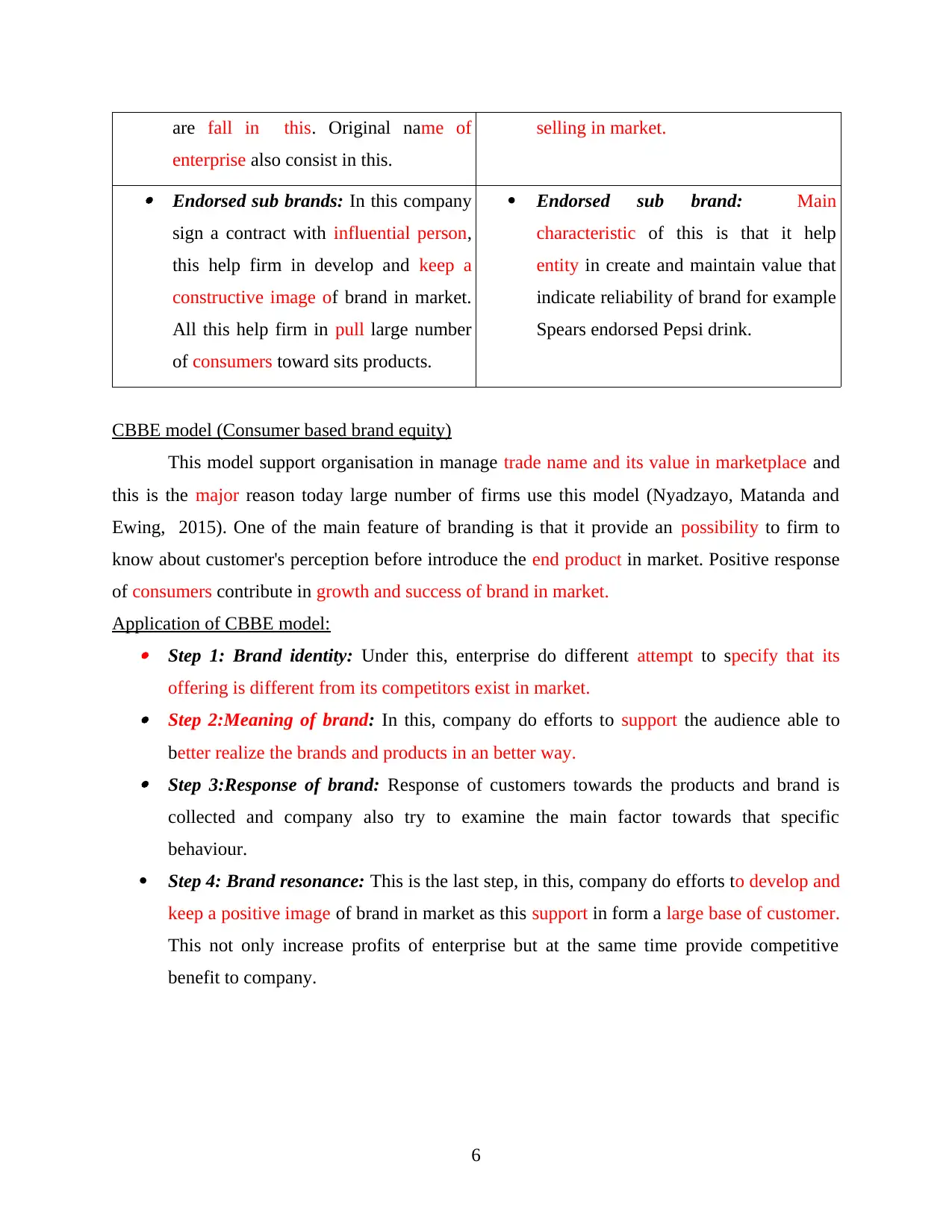
are fall in this. Original name of
enterprise also consist in this.
selling in market.
Endorsed sub brands: In this company
sign a contract with influential person,
this help firm in develop and keep a
constructive image of brand in market.
All this help firm in pull large number
of consumers toward sits products.
Endorsed sub brand: Main
characteristic of this is that it help
entity in create and maintain value that
indicate reliability of brand for example
Spears endorsed Pepsi drink.
CBBE model (Consumer based brand equity)
This model support organisation in manage trade name and its value in marketplace and
this is the major reason today large number of firms use this model (Nyadzayo, Matanda and
Ewing, 2015). One of the main feature of branding is that it provide an possibility to firm to
know about customer's perception before introduce the end product in market. Positive response
of consumers contribute in growth and success of brand in market.
Application of CBBE model: Step 1: Brand identity: Under this, enterprise do different attempt to specify that its
offering is different from its competitors exist in market. Step 2:Meaning of brand: In this, company do efforts to support the audience able to
better realize the brands and products in an better way. Step 3:Response of brand: Response of customers towards the products and brand is
collected and company also try to examine the main factor towards that specific
behaviour.
Step 4: Brand resonance: This is the last step, in this, company do efforts to develop and
keep a positive image of brand in market as this support in form a large base of customer.
This not only increase profits of enterprise but at the same time provide competitive
benefit to company.
6
enterprise also consist in this.
selling in market.
Endorsed sub brands: In this company
sign a contract with influential person,
this help firm in develop and keep a
constructive image of brand in market.
All this help firm in pull large number
of consumers toward sits products.
Endorsed sub brand: Main
characteristic of this is that it help
entity in create and maintain value that
indicate reliability of brand for example
Spears endorsed Pepsi drink.
CBBE model (Consumer based brand equity)
This model support organisation in manage trade name and its value in marketplace and
this is the major reason today large number of firms use this model (Nyadzayo, Matanda and
Ewing, 2015). One of the main feature of branding is that it provide an possibility to firm to
know about customer's perception before introduce the end product in market. Positive response
of consumers contribute in growth and success of brand in market.
Application of CBBE model: Step 1: Brand identity: Under this, enterprise do different attempt to specify that its
offering is different from its competitors exist in market. Step 2:Meaning of brand: In this, company do efforts to support the audience able to
better realize the brands and products in an better way. Step 3:Response of brand: Response of customers towards the products and brand is
collected and company also try to examine the main factor towards that specific
behaviour.
Step 4: Brand resonance: This is the last step, in this, company do efforts to develop and
keep a positive image of brand in market as this support in form a large base of customer.
This not only increase profits of enterprise but at the same time provide competitive
benefit to company.
6
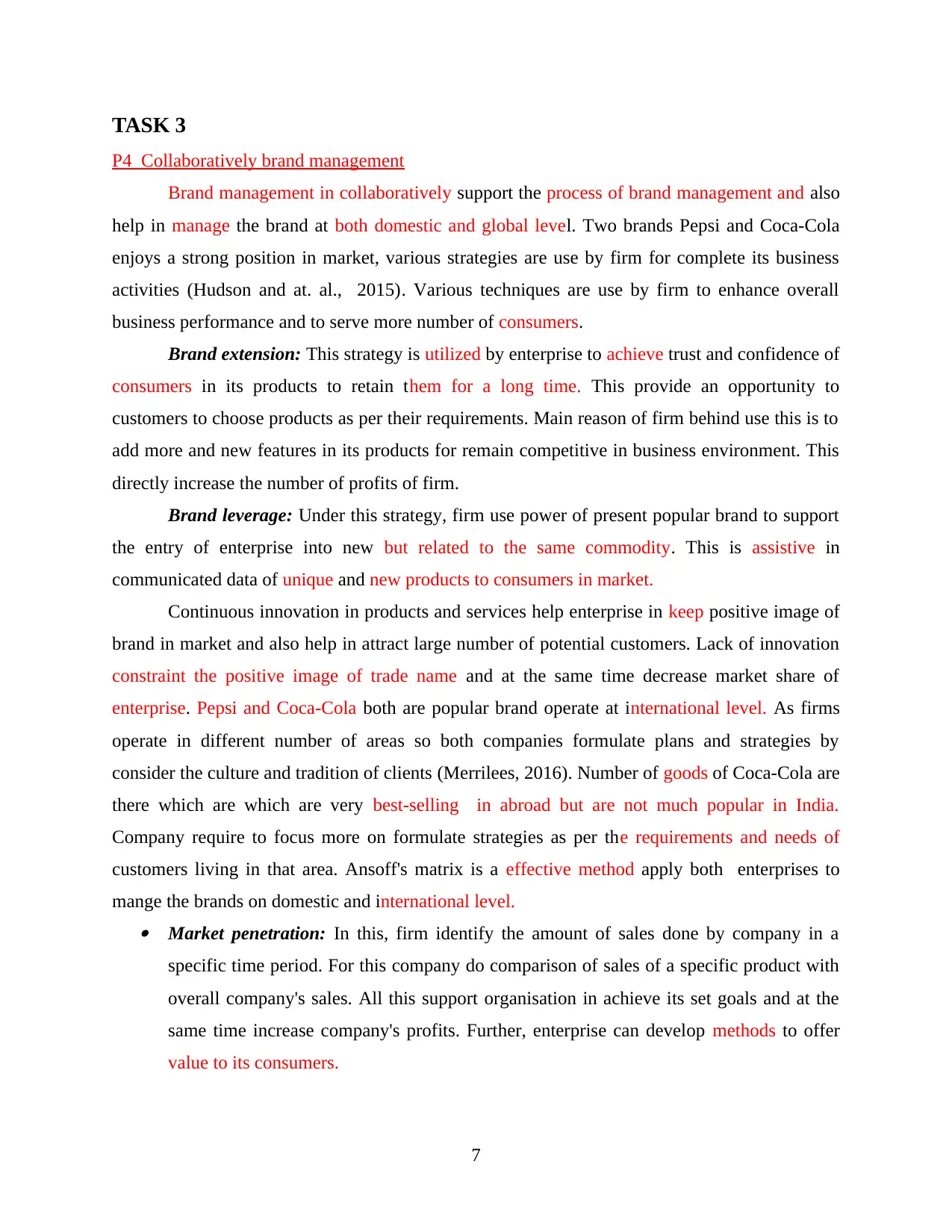
TASK 3
P4 Collaboratively brand management
Brand management in collaboratively support the process of brand management and also
help in manage the brand at both domestic and global level. Two brands Pepsi and Coca-Cola
enjoys a strong position in market, various strategies are use by firm for complete its business
activities (Hudson and at. al., 2015). Various techniques are use by firm to enhance overall
business performance and to serve more number of consumers.
Brand extension: This strategy is utilized by enterprise to achieve trust and confidence of
consumers in its products to retain them for a long time. This provide an opportunity to
customers to choose products as per their requirements. Main reason of firm behind use this is to
add more and new features in its products for remain competitive in business environment. This
directly increase the number of profits of firm.
Brand leverage: Under this strategy, firm use power of present popular brand to support
the entry of enterprise into new but related to the same commodity. This is assistive in
communicated data of unique and new products to consumers in market.
Continuous innovation in products and services help enterprise in keep positive image of
brand in market and also help in attract large number of potential customers. Lack of innovation
constraint the positive image of trade name and at the same time decrease market share of
enterprise. Pepsi and Coca-Cola both are popular brand operate at international level. As firms
operate in different number of areas so both companies formulate plans and strategies by
consider the culture and tradition of clients (Merrilees, 2016). Number of goods of Coca-Cola are
there which are which are very best-selling in abroad but are not much popular in India.
Company require to focus more on formulate strategies as per the requirements and needs of
customers living in that area. Ansoff's matrix is a effective method apply both enterprises to
mange the brands on domestic and international level. Market penetration: In this, firm identify the amount of sales done by company in a
specific time period. For this company do comparison of sales of a specific product with
overall company's sales. All this support organisation in achieve its set goals and at the
same time increase company's profits. Further, enterprise can develop methods to offer
value to its consumers.
7
P4 Collaboratively brand management
Brand management in collaboratively support the process of brand management and also
help in manage the brand at both domestic and global level. Two brands Pepsi and Coca-Cola
enjoys a strong position in market, various strategies are use by firm for complete its business
activities (Hudson and at. al., 2015). Various techniques are use by firm to enhance overall
business performance and to serve more number of consumers.
Brand extension: This strategy is utilized by enterprise to achieve trust and confidence of
consumers in its products to retain them for a long time. This provide an opportunity to
customers to choose products as per their requirements. Main reason of firm behind use this is to
add more and new features in its products for remain competitive in business environment. This
directly increase the number of profits of firm.
Brand leverage: Under this strategy, firm use power of present popular brand to support
the entry of enterprise into new but related to the same commodity. This is assistive in
communicated data of unique and new products to consumers in market.
Continuous innovation in products and services help enterprise in keep positive image of
brand in market and also help in attract large number of potential customers. Lack of innovation
constraint the positive image of trade name and at the same time decrease market share of
enterprise. Pepsi and Coca-Cola both are popular brand operate at international level. As firms
operate in different number of areas so both companies formulate plans and strategies by
consider the culture and tradition of clients (Merrilees, 2016). Number of goods of Coca-Cola are
there which are which are very best-selling in abroad but are not much popular in India.
Company require to focus more on formulate strategies as per the requirements and needs of
customers living in that area. Ansoff's matrix is a effective method apply both enterprises to
mange the brands on domestic and international level. Market penetration: In this, firm identify the amount of sales done by company in a
specific time period. For this company do comparison of sales of a specific product with
overall company's sales. All this support organisation in achieve its set goals and at the
same time increase company's profits. Further, enterprise can develop methods to offer
value to its consumers.
7
⊘ This is a preview!⊘
Do you want full access?
Subscribe today to unlock all pages.

Trusted by 1+ million students worldwide
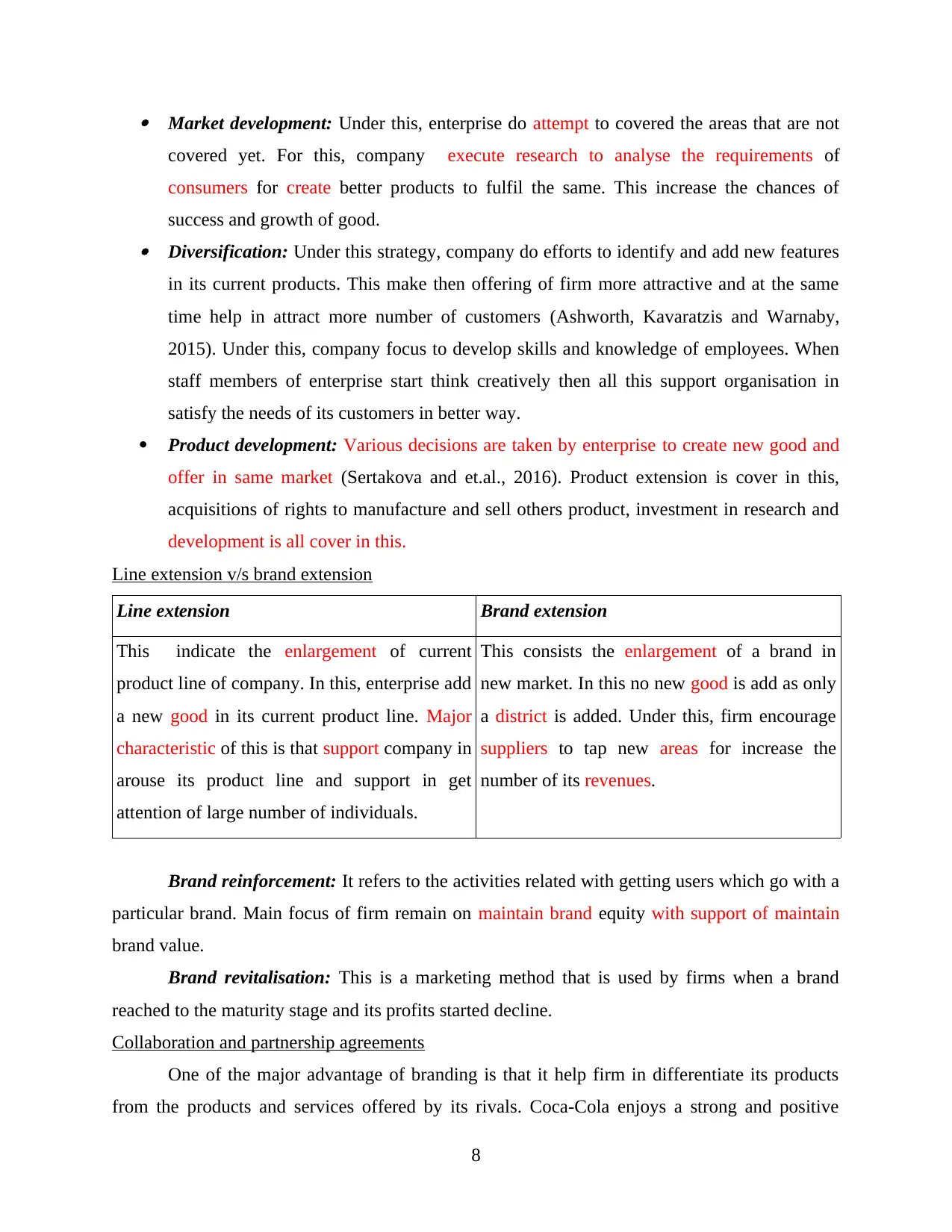
Market development: Under this, enterprise do attempt to covered the areas that are not
covered yet. For this, company execute research to analyse the requirements of
consumers for create better products to fulfil the same. This increase the chances of
success and growth of good. Diversification: Under this strategy, company do efforts to identify and add new features
in its current products. This make then offering of firm more attractive and at the same
time help in attract more number of customers (Ashworth, Kavaratzis and Warnaby,
2015). Under this, company focus to develop skills and knowledge of employees. When
staff members of enterprise start think creatively then all this support organisation in
satisfy the needs of its customers in better way.
Product development: Various decisions are taken by enterprise to create new good and
offer in same market (Sertakova and et.al., 2016). Product extension is cover in this,
acquisitions of rights to manufacture and sell others product, investment in research and
development is all cover in this.
Line extension v/s brand extension
Line extension Brand extension
This indicate the enlargement of current
product line of company. In this, enterprise add
a new good in its current product line. Major
characteristic of this is that support company in
arouse its product line and support in get
attention of large number of individuals.
This consists the enlargement of a brand in
new market. In this no new good is add as only
a district is added. Under this, firm encourage
suppliers to tap new areas for increase the
number of its revenues.
Brand reinforcement: It refers to the activities related with getting users which go with a
particular brand. Main focus of firm remain on maintain brand equity with support of maintain
brand value.
Brand revitalisation: This is a marketing method that is used by firms when a brand
reached to the maturity stage and its profits started decline.
Collaboration and partnership agreements
One of the major advantage of branding is that it help firm in differentiate its products
from the products and services offered by its rivals. Coca-Cola enjoys a strong and positive
8
covered yet. For this, company execute research to analyse the requirements of
consumers for create better products to fulfil the same. This increase the chances of
success and growth of good. Diversification: Under this strategy, company do efforts to identify and add new features
in its current products. This make then offering of firm more attractive and at the same
time help in attract more number of customers (Ashworth, Kavaratzis and Warnaby,
2015). Under this, company focus to develop skills and knowledge of employees. When
staff members of enterprise start think creatively then all this support organisation in
satisfy the needs of its customers in better way.
Product development: Various decisions are taken by enterprise to create new good and
offer in same market (Sertakova and et.al., 2016). Product extension is cover in this,
acquisitions of rights to manufacture and sell others product, investment in research and
development is all cover in this.
Line extension v/s brand extension
Line extension Brand extension
This indicate the enlargement of current
product line of company. In this, enterprise add
a new good in its current product line. Major
characteristic of this is that support company in
arouse its product line and support in get
attention of large number of individuals.
This consists the enlargement of a brand in
new market. In this no new good is add as only
a district is added. Under this, firm encourage
suppliers to tap new areas for increase the
number of its revenues.
Brand reinforcement: It refers to the activities related with getting users which go with a
particular brand. Main focus of firm remain on maintain brand equity with support of maintain
brand value.
Brand revitalisation: This is a marketing method that is used by firms when a brand
reached to the maturity stage and its profits started decline.
Collaboration and partnership agreements
One of the major advantage of branding is that it help firm in differentiate its products
from the products and services offered by its rivals. Coca-Cola enjoys a strong and positive
8
Paraphrase This Document
Need a fresh take? Get an instant paraphrase of this document with our AI Paraphraser
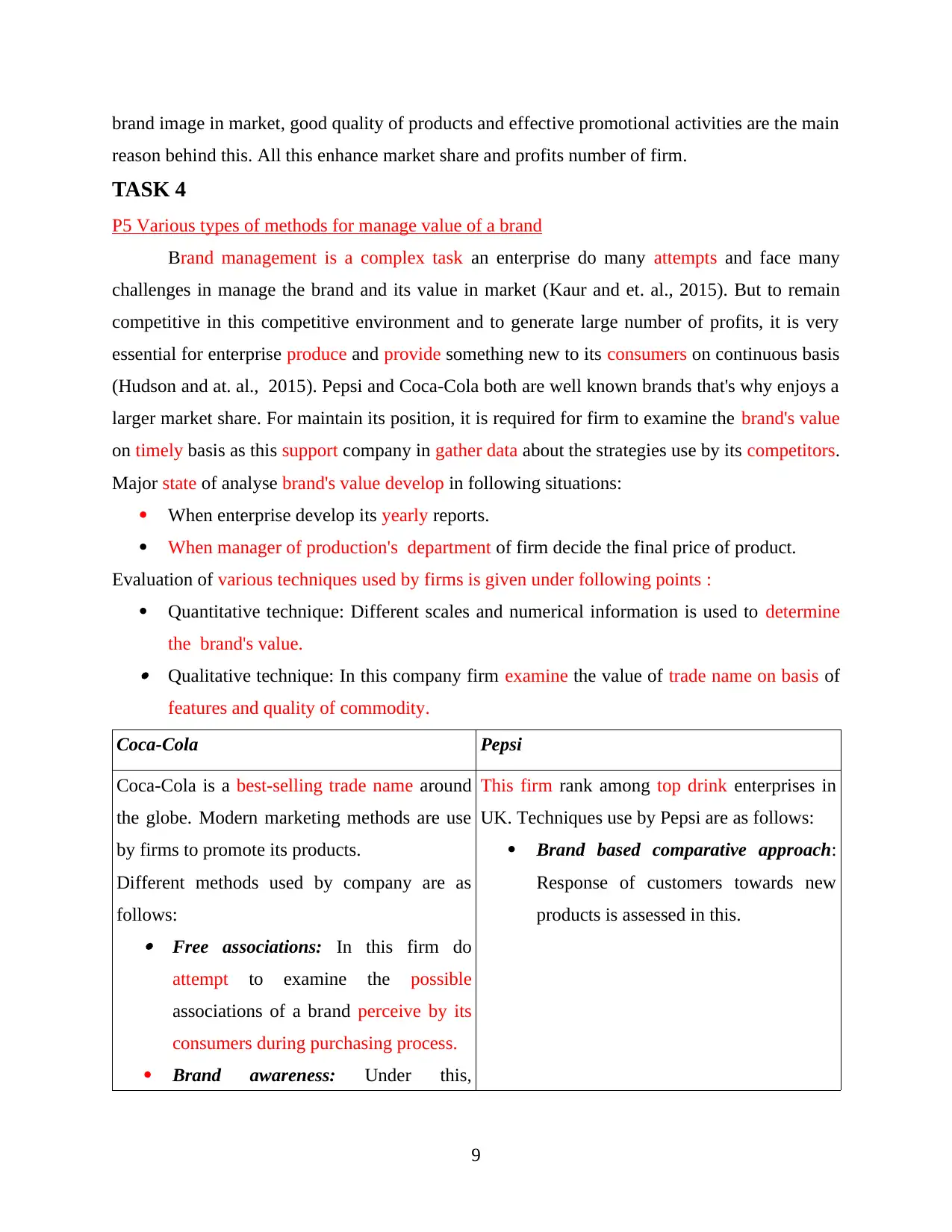
brand image in market, good quality of products and effective promotional activities are the main
reason behind this. All this enhance market share and profits number of firm.
TASK 4
P5 Various types of methods for manage value of a brand
Brand management is a complex task an enterprise do many attempts and face many
challenges in manage the brand and its value in market (Kaur and et. al., 2015). But to remain
competitive in this competitive environment and to generate large number of profits, it is very
essential for enterprise produce and provide something new to its consumers on continuous basis
(Hudson and at. al., 2015). Pepsi and Coca-Cola both are well known brands that's why enjoys a
larger market share. For maintain its position, it is required for firm to examine the brand's value
on timely basis as this support company in gather data about the strategies use by its competitors.
Major state of analyse brand's value develop in following situations:
When enterprise develop its yearly reports.
When manager of production's department of firm decide the final price of product.
Evaluation of various techniques used by firms is given under following points :
Quantitative technique: Different scales and numerical information is used to determine
the brand's value. Qualitative technique: In this company firm examine the value of trade name on basis of
features and quality of commodity.
Coca-Cola Pepsi
Coca-Cola is a best-selling trade name around
the globe. Modern marketing methods are use
by firms to promote its products.
Different methods used by company are as
follows: Free associations: In this firm do
attempt to examine the possible
associations of a brand perceive by its
consumers during purchasing process.
Brand awareness: Under this,
This firm rank among top drink enterprises in
UK. Techniques use by Pepsi are as follows:
Brand based comparative approach:
Response of customers towards new
products is assessed in this.
9
reason behind this. All this enhance market share and profits number of firm.
TASK 4
P5 Various types of methods for manage value of a brand
Brand management is a complex task an enterprise do many attempts and face many
challenges in manage the brand and its value in market (Kaur and et. al., 2015). But to remain
competitive in this competitive environment and to generate large number of profits, it is very
essential for enterprise produce and provide something new to its consumers on continuous basis
(Hudson and at. al., 2015). Pepsi and Coca-Cola both are well known brands that's why enjoys a
larger market share. For maintain its position, it is required for firm to examine the brand's value
on timely basis as this support company in gather data about the strategies use by its competitors.
Major state of analyse brand's value develop in following situations:
When enterprise develop its yearly reports.
When manager of production's department of firm decide the final price of product.
Evaluation of various techniques used by firms is given under following points :
Quantitative technique: Different scales and numerical information is used to determine
the brand's value. Qualitative technique: In this company firm examine the value of trade name on basis of
features and quality of commodity.
Coca-Cola Pepsi
Coca-Cola is a best-selling trade name around
the globe. Modern marketing methods are use
by firms to promote its products.
Different methods used by company are as
follows: Free associations: In this firm do
attempt to examine the possible
associations of a brand perceive by its
consumers during purchasing process.
Brand awareness: Under this,
This firm rank among top drink enterprises in
UK. Techniques use by Pepsi are as follows:
Brand based comparative approach:
Response of customers towards new
products is assessed in this.
9
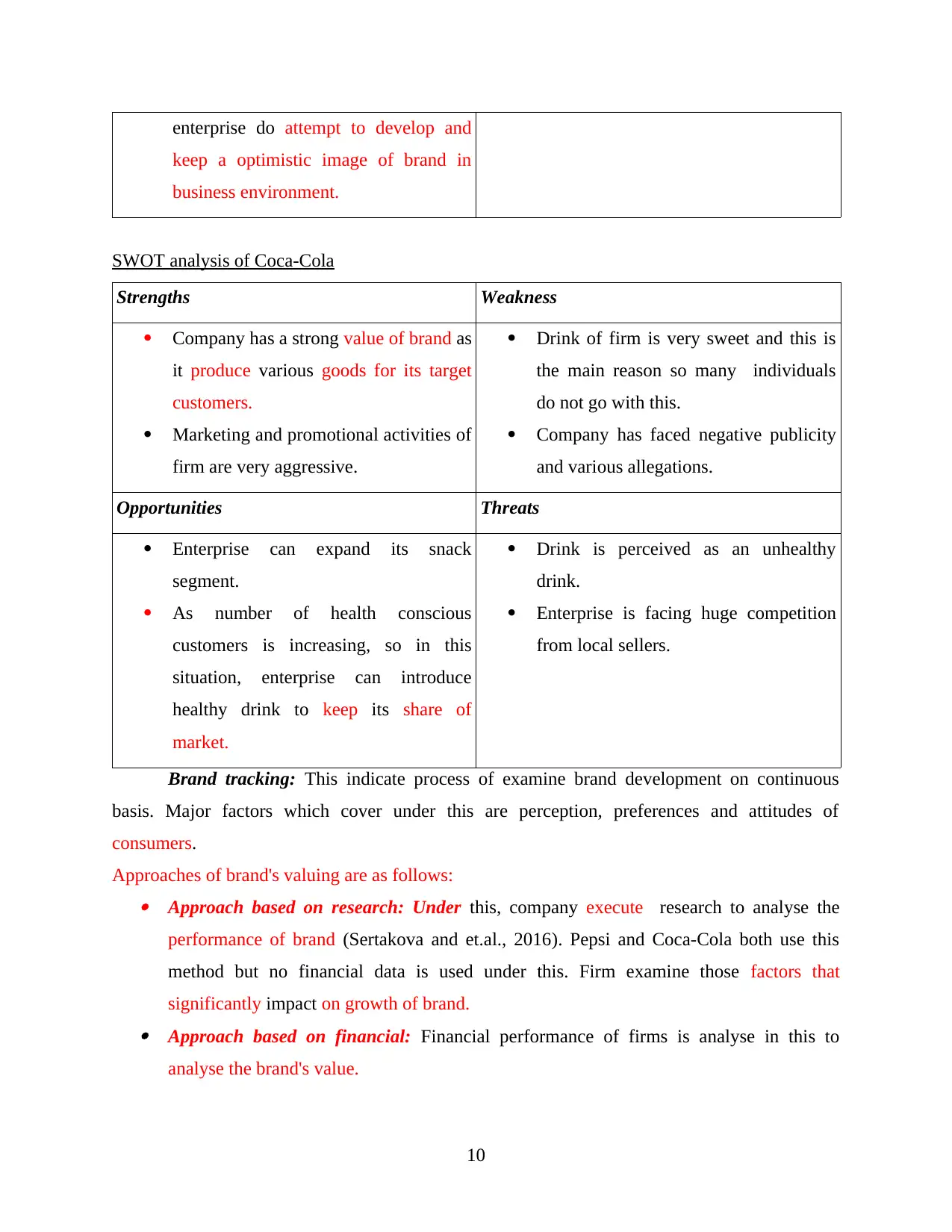
enterprise do attempt to develop and
keep a optimistic image of brand in
business environment.
SWOT analysis of Coca-Cola
Strengths Weakness
Company has a strong value of brand as
it produce various goods for its target
customers.
Marketing and promotional activities of
firm are very aggressive.
Drink of firm is very sweet and this is
the main reason so many individuals
do not go with this.
Company has faced negative publicity
and various allegations.
Opportunities Threats
Enterprise can expand its snack
segment.
As number of health conscious
customers is increasing, so in this
situation, enterprise can introduce
healthy drink to keep its share of
market.
Drink is perceived as an unhealthy
drink.
Enterprise is facing huge competition
from local sellers.
Brand tracking: This indicate process of examine brand development on continuous
basis. Major factors which cover under this are perception, preferences and attitudes of
consumers.
Approaches of brand's valuing are as follows: Approach based on research: Under this, company execute research to analyse the
performance of brand (Sertakova and et.al., 2016). Pepsi and Coca-Cola both use this
method but no financial data is used under this. Firm examine those factors that
significantly impact on growth of brand. Approach based on financial: Financial performance of firms is analyse in this to
analyse the brand's value.
10
keep a optimistic image of brand in
business environment.
SWOT analysis of Coca-Cola
Strengths Weakness
Company has a strong value of brand as
it produce various goods for its target
customers.
Marketing and promotional activities of
firm are very aggressive.
Drink of firm is very sweet and this is
the main reason so many individuals
do not go with this.
Company has faced negative publicity
and various allegations.
Opportunities Threats
Enterprise can expand its snack
segment.
As number of health conscious
customers is increasing, so in this
situation, enterprise can introduce
healthy drink to keep its share of
market.
Drink is perceived as an unhealthy
drink.
Enterprise is facing huge competition
from local sellers.
Brand tracking: This indicate process of examine brand development on continuous
basis. Major factors which cover under this are perception, preferences and attitudes of
consumers.
Approaches of brand's valuing are as follows: Approach based on research: Under this, company execute research to analyse the
performance of brand (Sertakova and et.al., 2016). Pepsi and Coca-Cola both use this
method but no financial data is used under this. Firm examine those factors that
significantly impact on growth of brand. Approach based on financial: Financial performance of firms is analyse in this to
analyse the brand's value.
10
⊘ This is a preview!⊘
Do you want full access?
Subscribe today to unlock all pages.

Trusted by 1+ million students worldwide
1 out of 15
Related Documents
Your All-in-One AI-Powered Toolkit for Academic Success.
+13062052269
info@desklib.com
Available 24*7 on WhatsApp / Email
![[object Object]](/_next/static/media/star-bottom.7253800d.svg)
Unlock your academic potential
Copyright © 2020–2025 A2Z Services. All Rights Reserved. Developed and managed by ZUCOL.





